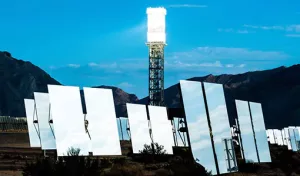The path to net zero emissions is a critical goal for nations and industries around the world, as the effects of climate change become increasingly apparent. One of the most promising renewable energy sources in this quest is solar power, which harnesses the sun’s energy to generate electricity. However, the efficiency of solar panels has long been a limiting factor in their widespread adoption. Recent advancements in concentrated solar panel technology, however, are poised to change this and significantly contribute to the global push for net zero emissions.
Concentrated solar power (CSP) systems differ from traditional photovoltaic (PV) solar panels in that they use mirrors or lenses to focus sunlight onto a small area, typically a solar cell or a thermal receiver. This concentrated sunlight can then be converted into electricity or used to produce heat, which can be stored and used to generate electricity when needed. The advantage of CSP systems is that they can achieve much higher efficiencies than traditional PV panels, which typically convert only 15-20% of the sunlight they receive into electricity.
One of the key challenges in CSP technology has been to develop materials and designs that can withstand the intense heat generated by the concentrated sunlight. Researchers have been making significant progress in this area, with new materials and coatings that can withstand temperatures of up to 1,000 degrees Celsius. This is important because higher temperatures enable more efficient energy conversion, leading to greater overall system efficiency.
Another area of innovation in CSP technology is the development of advanced solar concentrators. These devices use sophisticated optics to focus sunlight onto the solar cell or thermal receiver with minimal losses. Recent advancements in this field have led to the development of ultra-high-efficiency concentrators, which can achieve concentration ratios of up to 5,000 times the intensity of sunlight. This level of concentration allows for much smaller and more efficient solar cells, further reducing the cost and increasing the performance of CSP systems.
The combination of these advancements in materials and concentrator technology has led to a new generation of CSP systems that are capable of achieving efficiencies of up to 40%, nearly double that of traditional PV panels. This increased efficiency means that CSP systems can generate more electricity from the same amount of sunlight, reducing the amount of land and resources needed for solar power installations.
In addition to their higher efficiency, CSP systems also offer the advantage of energy storage. By using the concentrated sunlight to heat a thermal storage medium, such as molten salt, CSP plants can store energy for use when the sun is not shining. This ability to provide dispatchable power is a key advantage over traditional PV systems, which rely on batteries or other forms of energy storage to provide electricity when the sun is not shining.
The combination of higher efficiency, energy storage, and dispatchable power make CSP systems an attractive option for utility-scale solar power installations. As the cost of CSP technology continues to decrease and efficiency improves, it is expected that CSP will play an increasingly important role in the global push for net zero emissions.
In conclusion, concentrated solar panel efficiency improvements are a critical component in the path to net zero emissions. By harnessing the power of the sun more efficiently and effectively, CSP systems have the potential to significantly contribute to the global transition to renewable energy sources. As researchers continue to push the boundaries of CSP technology, it is likely that we will see even greater advancements in efficiency and performance, further solidifying the role of solar power in the fight against climate change.



